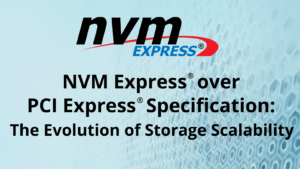
NVM Express® over PCI Express® Specification: The Evolution of Storage Scalability
BlogBy John Geldman, Director of SSD Industry Standards, KIOXIA America Inc.
From its inception, NVM Express® (NVMe®) technology has improved storage performance and complemented the PCI Express® (PCIe®) bus transport by providing a scalable, lower latency and more efficient solution than previous storage protocols. The NVMe over PCIe specification defines how NVMe architecture operates across the PCIe bus to transfer data to and from SSDs. With the latest release of the NVMe 2.0 specifications, adoption and development of NVMe over PCIe technology has become simpler by separating the NVMe/PCIe transport into its own specification.
History of PCIe Technology and NVMe Technology
PCIe technology was the first transport NVMe technology supported and NVMe devices based on PCIe architecture are currently the most common type of NVMe device. The NVMe Base Revision 1.0 specification implicitly included the PCIe transport interface as part of the NVMe model. As a result of this tight coupling of PCIe and NVMe in the NVMe specification, it has long been a common assumption that the NVM Express interface is tightly coupled to PCIe technology. While there is some truth to this, the fact is that the NVMe command layer is a distinct layer in the storage hierarchy; PCIe technology is one of possibly many physical interfaces that could carry the NVMe protocol. Tightly coupling the PCIe interface to NVMe in the specification also created an issue of not accounting for the continuous evolution of the PCIe specification when it NVMe was combined with the other transports in the specification. These are a few of the key reasons we separated the NVMe over PCIe transport, and additional transports, into specifications of their own.
NVMe 2.0 Specifications: Refactored for Simplicity
The refactoring of the NVMe 2.0 specifications enables simpler adoption of NVMe over PCIe technology by breaking out the NVMe PCIe transport into a specification of its own. The reorganization of the specification enables a clear delineation of PCI Express based transport requirements and general NVM Express requirements , which are transport agnostic. An important outcome is achieving consistency in common NVMe features and behaviors, regardless of whether the device complies to NVMe over PCIe or NVMe over Fabrics.
NVMe over PCIe technology performance
According to Intel, the current generation of NVMe over PCIe storage is 6x faster than SATA and future generations are expected to be up to 26x faster. NVMe technology has also benefited from the constant bandwidth and functional improvements in the PCI Express interface, which has doubled the performance capabilities with every release. NVMe technology currently utilizes the PCIe 4.0 specification and is beginning to shift to PCIe 5.0 architecture as it becomes more popular in the industry. The introduction and adoption of the upcoming PCIe 6.0 specification is expected to further improve storage performance.
NVMe/PCIe technology has become the industry standard because it allows efficient accessing and processing of data, benefiting a wide range of workloads present in client, cloud and enterprise markets.
Learn More
I was recently interviewed about how NVM Express has benefited from utilizing PCIe architecture. I invite you to watch my interview to learn more on this topic.
Find the full series of NVMe 2.0 specifications videos on the NVM Express YouTube Channel to learn more about the latest features and how NVMe technology is improving storage performance.